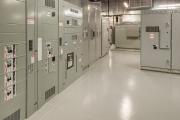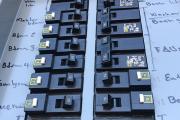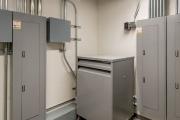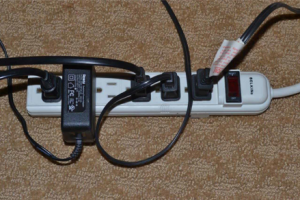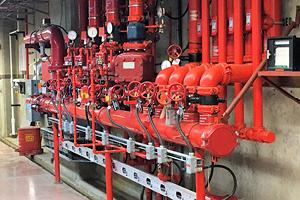Electrical distribution system
Visual Observations |
Equipment |
Definition |
Observations |
| Cables and bus |
Distributes electrical power throughout a building, connecting various components of an electrical distribution system. |
No sharp bends |
|
| Switchgear |
Combination of electrical disconnect switches, fuses or circuit breakers used to control, protect and isolate electrical equipment. Switchgear is used both to deenergize equipment to allow work to be done and to clear faults downstream. |
Covers in place |
|
| Circuit breakers |
Controlling power to a circuit as well as providing protection to equipment in that circuit by interrupting fault conditions. |
Enclosed |
|
| Transformers |
Device that transfers electric energy from one alternating current circuit to one or more other circuits, either increasing (stepping up) or reducing (stepping down) the voltage. |
Open and accessible |
Operation and maintenance |
Keep it ____________ |
||
|
Read and follow all manufacturers' guidelines and instructions for periodic service, maintenance and inspection of equipment and systems. Caution — Always deenergize electrical equipment before testing, cleaning or performing maintenance. |
Cool |
All vent and air circulation openings must be clear and operational. |
|
| Clean | Dust and/or dirt accumulations should be removed from the equipment and surroundings. Space in switchrooms and switchgear enclosures should not be used for storing tools, supplies or other material. | ||
| Dry | Precaution should be taken to prevent steam, chemicals, moisture or condensation from entering electrical enclosures. | ||
| Tight |
Clean and tighten all loose parts and replace any that are worn. Equipment should be manually exercised to establish that moving parts do not bind and are free to operate. |
||
Electrical testing |
Equipment |
Testing |
Frequency |
|
Testing frequency guidelines should be tempered by the size of the equipment, the location of the equipment, the frequency of operation and the criticality it represents. |
Cables and bus |
Infrared thermography |
3 years |
|
Visual inspect/clean/adjust |
3 years |
||
|
Switchgear |
Infrared thermography |
3 years |
|
|
Visual inspect/clean/adjust |
3 years |
||
|
Contact resistance test |
3 years |
||
|
Circuit breakers |
Infrared thermography |
3 years |
|
|
Visual inspect/clean/adjust |
3 years |
||
|
Contact resistance, breaker trip, relay calibration |
3 years |
||
|
Transformers |
Infrared thermography |
3 years |
|
|
Visual inspect- |
Annually |
||
|
Power factor, turns ratio |
5 years |
||
|
In addition: |
|
|
|
|
Dissolved gas analysis, oil screen tests |
Yearly |
For a more detailed description on electrical maintenance and testing, consult Standard for an Electrical Preventive Maintenance (EPM) program.
This material is provided for informational purposes only and does not provide any coverage or guarantee loss prevention. The examples in this material are provided as hypothetical and for illustration purposes only. The Hanover Insurance Company and its affiliates and subsidiaries (“The Hanover”) specifically disclaim any warranty or representation that acceptance of any recommendations contained herein will make any premises, or operation safe or in compliance with any law or regulation. By providing this information to you, The Hanover does not assume (and specifically disclaims) any duty, undertaking or responsibility to you. The decision to accept or implement any recommendation(s) or advice contained in this material must be made by you.
LC MAR 2019 13-349
171-1084 (3/14)
Electrical distribution system
Visual Observations |
Equipment |
Definition |
Observations |
| Cables and bus |
Distributes electrical power throughout a building, connecting various components of an electrical distribution system. |
No sharp bends |
|
| Switchgear |
Combination of electrical disconnect switches, fuses or circuit breakers used to control, protect and isolate electrical equipment. Switchgear is used both to deenergize equipment to allow work to be done and to clear faults downstream. |
Covers in place |
|
| Circuit breakers |
Controlling power to a circuit as well as providing protection to equipment in that circuit by interrupting fault conditions. |
Enclosed |
|
| Transformers |
Device that transfers electric energy from one alternating current circuit to one or more other circuits, either increasing (stepping up) or reducing (stepping down) the voltage. |
Open and accessible |
Operation and maintenance |
Keep it ____________ |
||
|
Read and follow all manufacturers' guidelines and instructions for periodic service, maintenance and inspection of equipment and systems. Caution — Always deenergize electrical equipment before testing, cleaning or performing maintenance. |
Cool |
All vent and air circulation openings must be clear and operational. |
|
| Clean | Dust and/or dirt accumulations should be removed from the equipment and surroundings. Space in switchrooms and switchgear enclosures should not be used for storing tools, supplies or other material. | ||
| Dry | Precaution should be taken to prevent steam, chemicals, moisture or condensation from entering electrical enclosures. | ||
| Tight |
Clean and tighten all loose parts and replace any that are worn. Equipment should be manually exercised to establish that moving parts do not bind and are free to operate. |
||
Electrical testing |
Equipment |
Testing |
Frequency |
|
Testing frequency guidelines should be tempered by the size of the equipment, the location of the equipment, the frequency of operation and the criticality it represents. |
Cables and bus |
Infrared thermography |
3 years |
|
Visual inspect/clean/adjust |
3 years |
||
|
Switchgear |
Infrared thermography |
3 years |
|
|
Visual inspect/clean/adjust |
3 years |
||
|
Contact resistance test |
3 years |
||
|
Circuit breakers |
Infrared thermography |
3 years |
|
|
Visual inspect/clean/adjust |
3 years |
||
|
Contact resistance, breaker trip, relay calibration |
3 years |
||
|
Transformers |
Infrared thermography |
3 years |
|
|
Visual inspect- |
Annually |
||
|
Power factor, turns ratio |
5 years |
||
|
In addition: |
|
|
|
|
Dissolved gas analysis, oil screen tests |
Yearly |
For a more detailed description on electrical maintenance and testing, consult Standard for an Electrical Preventive Maintenance (EPM) program.
This material is provided for informational purposes only and does not provide any coverage or guarantee loss prevention. The examples in this material are provided as hypothetical and for illustration purposes only. The Hanover Insurance Company and its affiliates and subsidiaries (“The Hanover”) specifically disclaim any warranty or representation that acceptance of any recommendations contained herein will make any premises, or operation safe or in compliance with any law or regulation. By providing this information to you, The Hanover does not assume (and specifically disclaims) any duty, undertaking or responsibility to you. The decision to accept or implement any recommendation(s) or advice contained in this material must be made by you.
LC MAR 2019 13-349
171-1084 (3/14)
Electrical distribution system
Visual Observations |
Equipment |
Definition |
Observations |
| Cables and bus |
Distributes electrical power throughout a building, connecting various components of an electrical distribution system. |
No sharp bends |
|
| Switchgear |
Combination of electrical disconnect switches, fuses or circuit breakers used to control, protect and isolate electrical equipment. Switchgear is used both to deenergize equipment to allow work to be done and to clear faults downstream. |
Covers in place |
|
| Circuit breakers |
Controlling power to a circuit as well as providing protection to equipment in that circuit by interrupting fault conditions. |
Enclosed |
|
| Transformers |
Device that transfers electric energy from one alternating current circuit to one or more other circuits, either increasing (stepping up) or reducing (stepping down) the voltage. |
Open and accessible |
Operation and maintenance |
Keep it ____________ |
||
|
Read and follow all manufacturers' guidelines and instructions for periodic service, maintenance and inspection of equipment and systems. Caution — Always deenergize electrical equipment before testing, cleaning or performing maintenance. |
Cool |
All vent and air circulation openings must be clear and operational. |
|
| Clean | Dust and/or dirt accumulations should be removed from the equipment and surroundings. Space in switchrooms and switchgear enclosures should not be used for storing tools, supplies or other material. | ||
| Dry | Precaution should be taken to prevent steam, chemicals, moisture or condensation from entering electrical enclosures. | ||
| Tight |
Clean and tighten all loose parts and replace any that are worn. Equipment should be manually exercised to establish that moving parts do not bind and are free to operate. |
||
Electrical testing |
Equipment |
Testing |
Frequency |
|
Testing frequency guidelines should be tempered by the size of the equipment, the location of the equipment, the frequency of operation and the criticality it represents. |
Cables and bus |
Infrared thermography |
3 years |
|
Visual inspect/clean/adjust |
3 years |
||
|
Switchgear |
Infrared thermography |
3 years |
|
|
Visual inspect/clean/adjust |
3 years |
||
|
Contact resistance test |
3 years |
||
|
Circuit breakers |
Infrared thermography |
3 years |
|
|
Visual inspect/clean/adjust |
3 years |
||
|
Contact resistance, breaker trip, relay calibration |
3 years |
||
|
Transformers |
Infrared thermography |
3 years |
|
|
Visual inspect- |
Annually |
||
|
Power factor, turns ratio |
5 years |
||
|
In addition: |
|
|
|
|
Dissolved gas analysis, oil screen tests |
Yearly |
For a more detailed description on electrical maintenance and testing, consult Standard for an Electrical Preventive Maintenance (EPM) program.
This material is provided for informational purposes only and does not provide any coverage or guarantee loss prevention. The examples in this material are provided as hypothetical and for illustration purposes only. The Hanover Insurance Company and its affiliates and subsidiaries (“The Hanover”) specifically disclaim any warranty or representation that acceptance of any recommendations contained herein will make any premises, or operation safe or in compliance with any law or regulation. By providing this information to you, The Hanover does not assume (and specifically disclaims) any duty, undertaking or responsibility to you. The decision to accept or implement any recommendation(s) or advice contained in this material must be made by you.
LC MAR 2019 13-349
171-1084 (3/14)
Electrical distribution system
Visual Observations |
Equipment |
Definition |
Observations |
| Cables and bus |
Distributes electrical power throughout a building, connecting various components of an electrical distribution system. |
No sharp bends |
|
| Switchgear |
Combination of electrical disconnect switches, fuses or circuit breakers used to control, protect and isolate electrical equipment. Switchgear is used both to deenergize equipment to allow work to be done and to clear faults downstream. |
Covers in place |
|
| Circuit breakers |
Controlling power to a circuit as well as providing protection to equipment in that circuit by interrupting fault conditions. |
Enclosed |
|
| Transformers |
Device that transfers electric energy from one alternating current circuit to one or more other circuits, either increasing (stepping up) or reducing (stepping down) the voltage. |
Open and accessible |
Operation and maintenance |
Keep it ____________ |
||
|
Read and follow all manufacturers' guidelines and instructions for periodic service, maintenance and inspection of equipment and systems. Caution — Always deenergize electrical equipment before testing, cleaning or performing maintenance. |
Cool |
All vent and air circulation openings must be clear and operational. |
|
| Clean | Dust and/or dirt accumulations should be removed from the equipment and surroundings. Space in switchrooms and switchgear enclosures should not be used for storing tools, supplies or other material. | ||
| Dry | Precaution should be taken to prevent steam, chemicals, moisture or condensation from entering electrical enclosures. | ||
| Tight |
Clean and tighten all loose parts and replace any that are worn. Equipment should be manually exercised to establish that moving parts do not bind and are free to operate. |
||
Electrical testing |
Equipment |
Testing |
Frequency |
|
Testing frequency guidelines should be tempered by the size of the equipment, the location of the equipment, the frequency of operation and the criticality it represents. |
Cables and bus |
Infrared thermography |
3 years |
|
Visual inspect/clean/adjust |
3 years |
||
|
Switchgear |
Infrared thermography |
3 years |
|
|
Visual inspect/clean/adjust |
3 years |
||
|
Contact resistance test |
3 years |
||
|
Circuit breakers |
Infrared thermography |
3 years |
|
|
Visual inspect/clean/adjust |
3 years |
||
|
Contact resistance, breaker trip, relay calibration |
3 years |
||
|
Transformers |
Infrared thermography |
3 years |
|
|
Visual inspect- |
Annually |
||
|
Power factor, turns ratio |
5 years |
||
|
In addition: |
|
|
|
|
Dissolved gas analysis, oil screen tests |
Yearly |
For a more detailed description on electrical maintenance and testing, consult Standard for an Electrical Preventive Maintenance (EPM) program.
This material is provided for informational purposes only and does not provide any coverage or guarantee loss prevention. The examples in this material are provided as hypothetical and for illustration purposes only. The Hanover Insurance Company and its affiliates and subsidiaries (“The Hanover”) specifically disclaim any warranty or representation that acceptance of any recommendations contained herein will make any premises, or operation safe or in compliance with any law or regulation. By providing this information to you, The Hanover does not assume (and specifically disclaims) any duty, undertaking or responsibility to you. The decision to accept or implement any recommendation(s) or advice contained in this material must be made by you.
LC MAR 2019 13-349
171-1084 (3/14)




